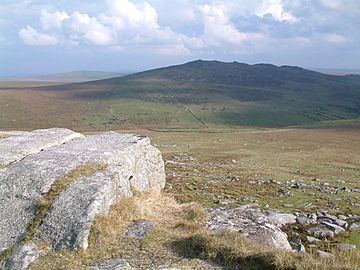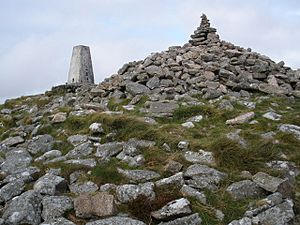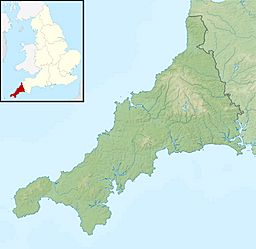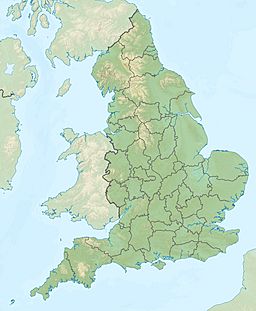Brown Willy facts for kids
Quick facts for kids Brown Willy |
|
|---|---|
| Bronn Wennili | |

Brown Willy from the summit of Rough Tor
|
|
| Highest point | |
| Elevation | 420 m (1,380 ft) |
| Prominence | 314 m (1,030 ft) |
| Parent peak | High Willhays |
| Listing | Marilyn, County Top |
| Geography | |
| Location | Bodmin Moor, Cornwall, England, UK |
| OS grid | SX158799 |
| Topo map | OS Landranger 201 |
Brown Willy is a famous hill in Cornwall, England. It might mean "hill of swallows" (from Cornish Bronn Wennili) or "highest hill" (from Cornish Bronn Ewhella) in the Cornish language. This hill is the highest point on Bodmin Moor and in all of Cornwall. It stands about 420 meters (1,378 feet) above sea level.
Brown Willy is located about 4 kilometers (2.5 miles) northwest of Bolventor. It is also about 6.5 kilometers (4 miles) southeast of Camelford. The hill looks different depending on where you see it from. From far away, it can look like a cone. But when you get closer, it spreads out into a long hill with several peaks.
Contents
What's in a Name?
The name "Brown Willy" has an interesting history. The first part, "Brown," comes from an old word meaning "hillside" or "breast of a hill." This word is common in many old British place names.
Some experts, like Henry Jenner, thought the name came from the Cornish words bronn ughella/ewhella. This means "highest hill," which makes sense because it's the tallest spot in Cornwall. There's another high hill in Devon called High Willhays, which supports this idea.
More recently, another expert, Craig Weatherhill, suggested a different meaning. He thinks it comes from 'Bronn Wennili', which means 'Hill of Swallows'.
The name has changed a lot over hundreds of years. It was spelled in many ways, like Brunwenely and Brounwenely.
Why People Talk About the Name
Brown Willy's name often appears on lists of unusual place names. In 2012, some people wanted to change its name back to Bronn Wennili. They thought it would sound nicer for people living there and for tourists.
However, many people in Cornwall didn't like this idea. One person said, "It's been Brown Willy for as far back as living memory goes." They believed it would always be called that, no matter what official name it had. Even a newspaper, The Daily Telegraph, wrote an article supporting the old name. They told the campaigners to "keep their hands off Brown Willy."
Exploring Brown Willy's Landscape
Brown Willy's top is 420 meters (1,378 feet) above sea level. This makes it the highest point on Bodmin Moor and in the whole county of Cornwall. The land around it is typical of Bodmin Moor. You'll see tors, which are rocky hills, surrounded by open moorland.
Streams and marshy areas are common near the summit. The River Fowey even starts nearby. There are natural piles of granite rocks around the top. One famous pile is called the Cheesewring. It's made of five separate rocks stacked on top of each other, getting bigger towards the top.
The Land Around the Hill
Brown Willy is part of a large piece of land called Fernacre. This land covers about 494 hectares (1,221 acres). It also includes a farmhouse with five bedrooms. In 2016, this property was put up for sale for a lot of money. It was sold the next year to a new owner.
The new owner has rights to let animals graze there. They also have rights to hunt certain animals like deer and birds. But don't worry, the public can still walk on Brown Willy. This is thanks to a law called the Countryside and Rights of Way Act 2000.
Ancient Stone Piles: Brown Willy Cairns

On the top of Brown Willy, you can find two man-made piles of rocks called cairns. One is called Brown Willy Summit Cairn or Brown Willy North Cairn. It sits next to an Ordnance Survey triangulation station. This station helps mapmakers measure the land.
The Cornish word for "cairn" is karn. Some people think Cornwall's ancient name, Kernow, might be related to this word. Experts like William Copeland Borlase described these cairns as "bowl" or "cone" shaped. He also called them "burial mounds," but many don't have burials inside.
The Brown Willy Summit Cairn has never been dug up by archaeologists. Old stories say an ancient Cornish king might be buried underneath it. Studies of other cairns on Bodmin Moor show that many were built in the early Bronze Age. This means they are very old, dating back to around 2162 to 1746 BC. These cairns are still in good shape because they are in a remote and hard-to-reach place. Many rocks from other cairns were taken over the years to build walls.
Some people believe these cairns were built for a special purpose. Rodney Castleden suggested that the sun rises over Brown Willy North Cairn during the autumn equinox. This might mean the cairns were used to track the sun or stars.
Fun Things to Do at Brown Willy
Here, in his deafness and his loneliness,
My father's sad grey eyes in gathering dusk
Saw Roughtor and Brown Willy hide the view
Of that bold coast-line where he was not born—
Brown Willy is a very popular spot for people who love to walk. It's even called one of "the UK's best-loved high points."
Every New Year's Day, there's an annual race that includes the hill. The race starts and finishes at Jamaica Inn. This old coaching inn became famous because of Daphne du Maurier's 1936 novel.
Special Beliefs About the Hill
Some groups have special beliefs about Brown Willy. Members of the Aetherius Society see it as a "sacred mountain." This group was started in 1954 by George King. They believe that Brown Willy received "holy energy" on November 23rd. They call this day "Charging Day" and gather at the hill each year to celebrate. They believe the sun lines up with "positive and negative rocks" on that day. This group also has other "holy mountains" in places like Tanzania, California, Australia, and Devon.
The Brown Willy Effect
Brown Willy is known for a special weather event called the Brown Willy effect. This happens when heavy rain forms over the high ground of the hill. Then, this rain travels a long way downwind.
This effect can cause very heavy, local rainfall. Sometimes, it can even lead to serious flash floods. A famous example is the Boscastle flood of 2004. In another case, on March 27, 2006, a continuous line of showers stretched 233 kilometers (145 miles) from Brown Willy all the way to Oxfordshire!
Life Around the Hill
Brown Willy is a bit different from other hills on Bodmin Moor. There isn't much proof of people living right around it in ancient times. Instead, it might have been a shared area for people from nearby settlements. They might have used the ridge as a special path for ceremonies.
You won't find many old house circles or platforms near the very top. However, remains of houses have been found on the lower slopes. These houses were built simply and were probably only used at certain times of the year. Many of them were built in places where people could clearly see the top of Brown Willy and the nearby hill of Rough Tor. This suggests that these hilltops were seen as very special places by ancient people.
Brown Willy in Media
Brown Willy is also the setting for a comedy film. The movie is about two old school friends who go on a funny and misguided trip. It was written and directed by Brett Harvey.



